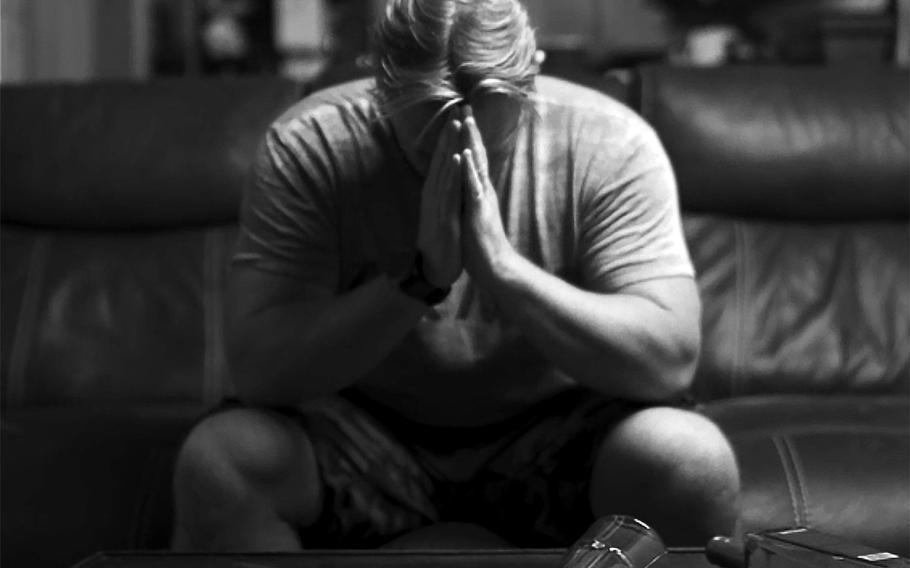
Sixty percent of veterans who die from suicide each year had no recent engagement with health care services at the Department of Veterans Affairs, according to the agency. (Defense Department)
WASHINGTON — Sixty percent of veterans who die from suicide each year had no recent engagement with health care services at the Department of Veterans Affairs.
More so, many of the veterans who did reach out for help waited until they were at imminent risk of suicide, according to testimony at a hearing Tuesday held by the House Committee on Veterans’ Affairs health oversight subpanel.
“We’re not catching these problems early enough,” said Rep. Morgan Luttrell, R-Texas, a retired Navy SEAL. The veterans’ bodies and brains often are “broken” by the time they ask for help, he said.
The purpose of the hearing was to get a status report on a two-year-old VA grant program that seeks to address problems veterans are facing before they are in crisis and make a meaningful difference in their lives.
The Staff Sergeant Parker Gordon Fox Suicide Prevention Grant Program has a mission to fund nonclinical community services that help veterans cope with life stressors such as financial problems, family discord and the sense of loss from leaving the military community for civilian life.
Congress has funded the suicide prevention grants with $174 million through fiscal 2025. The dollars support programs that link veterans with nonclinical assistance in the cities and towns where they live, work and attend school. Qualifying organizations can apply for up to $750,000 a year in funding.
“Given the multiple factors that may lead to suicide death, prevention requires a comprehensive public health approach,” Erica Scavella, VA assistant under secretary for health for clinical services, told lawmakers at a hearing Tuesday that examined unconventional services that are showing promise.
Preventing veteran suicide requires the VA to provide mental health care and collaborate with local organizations offering nonclinical help, Scavella said. The grants enable the VA to partner with service providers helping veterans with housing, employment, legal problems and social support, among other issues.
“This requires moving away from the belief that suicide prevention rests solely on the shoulders of our mental-health providers and further toward engaging outside of clinical health care organizations to decrease the individual and societal risks of suicide,” she said.
Ken Falke, a Navy veteran, testified about his work with veterans and active-duty service members at two nonprofits that he and his wife founded — the EOD Warrior Foundation in 2004 and the Boulder Crest Foundation in 2010. The organizations have served more than 100,000 participants.
Falke, who served as a bomb disposal specialist for 21 years, said a “major driver of my work is the nearly unspeakable truth that since 9/11 we have lost more members of the bomb disposal community to suicide than we did on the battlefield.”

A veteran walks with a loved one on the grounds of Boulder Crest Foundation, which is dedicated to helping veterans with post-traumatic stress disorder. (Boulder Crest Foundation)
His organizations focus on easing post-traumatic stress disorder symptoms through “post-traumatic growth” techniques, which refer to the insight, awareness and skills that might be gained through adversity.
Boulder Crest Foundation has peer-based “warrior PATHH programs” that give veterans the “training, skills and support needed to transform their struggle into lifelong growth,” according to the organization’s website. PATHH stands for “progressive and alternative training for helping heroes.”
“At Boulder Crest Foundation, our vision was to create a place and programs where combat veterans could transform their struggles into strength and growth,” Falke said. “We run our warrior PATHH programs as male and female cohorts. In the last three years, we’ve had to increase the number of female programs because of the demand — and that’s kind of how we respond as a small nonprofit.”
He urged the VA to bring a greater sense of urgency to the risk of veterans’ suicide and efforts to address it.
Falke also said there is a need to look beyond mental health treatment to lower the suicide rate.
“The mental health system is nearly exclusively focused on one thing when it comes to clients and patients and that is managing and mitigating symptoms associated with times of struggle, often through a combination of medication and talk therapy,” he said. “This approach is not working for far too many people, something made evident by the highly distressing statistics around veterans mental health and suicide.”
Veterans are at a higher risk of suicide than the general population, according to VA statistics.
Suicide was the second-leading cause of death among veterans younger than 45 in 2021, according to the VA’s 2023 annual report on veterans suicide. There were 6,392 veteran suicide deaths in 2021, an increase of 114 from the previous year, according to the report, published last month.
From 2020-21, the suicide rate increased 6.3% for male veterans and 24.1% for female veterans, the VA reported. By contrast, the suicide rate in the general population rose 4.9% for men and 2.6% for women during the same time.
Lawmakers at the hearing encouraged the VA to incorporate promising and innovative approaches for treatment underway at the state and local levels.
“You should be able to ask anybody about who’s leading the charge on suicides in America, and the first words out of their mouth should be the VA,” Luttrell said.